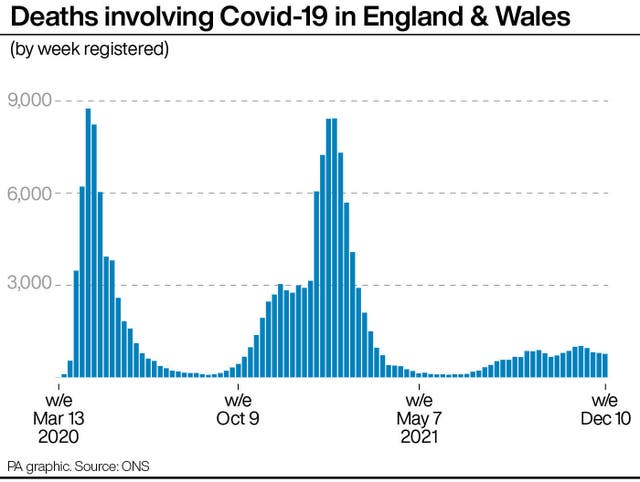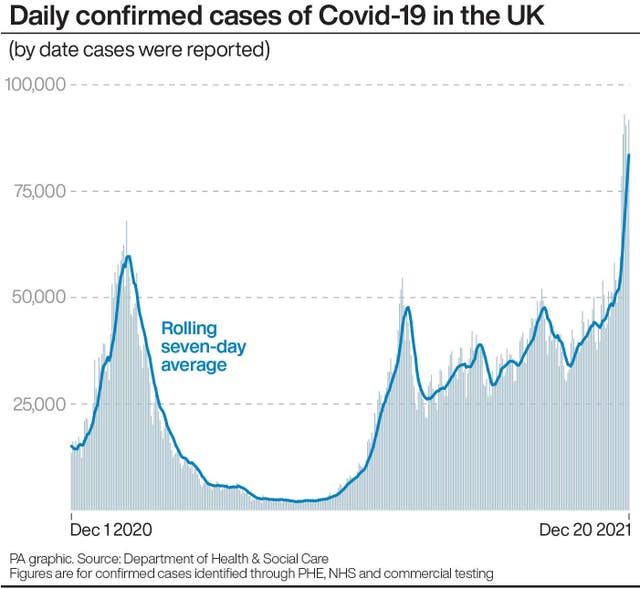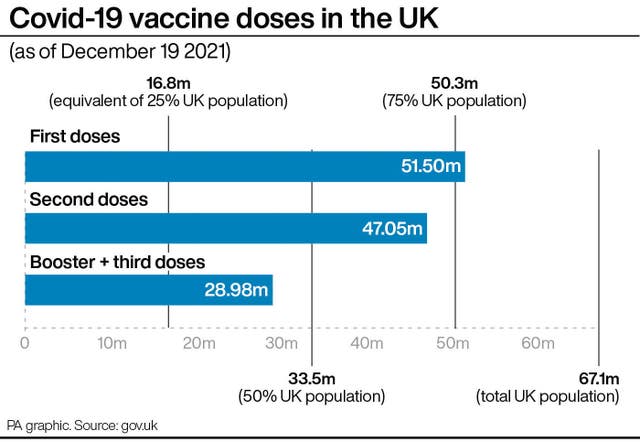Omicron transmission ‘eye-wateringly’ high, but uncertainties remain – expert
Sir Jeremy Farrar said the new variant is doubling every two days and it is not yet known if that rate is levelling off.

Transmission of the Omicron variant is “eye-wateringly high”, though there is still uncertainty about its impact on the NHS and wider services, a leading expert has said.
Sir Jeremy Farrar, director of the global charitable foundation Wellcome, said “we’re in the most difficult, most uncertain time, perhaps of the whole pandemic, certainly since March of 2020.”
It comes as Cabinet Office minister Steve Barclay said the Government will release further details on Tuesday about supporting firms struggling due to the advice for people to rethink some of their Christmas plans.
Sir Jeremy told BBC Radio 4’s Today programme: “Omicron is spreading unbelievably fast. It is a phenomenal variant, transmission is eye-wateringly high, but there is great uncertainty.
“My personal view is that I think we can wait at the moment until there are more restrictions formally placed, but each of us can do a lot of things today that would make the chances of further restrictions lighter.
“More data will be available today and tomorrow and I would act on those if transmission is rising still and if hospitalisations are going up across the country.”

People were already changing their behaviour and workplaces were breaking up for the Christmas break, meaning previous predictions of between six and 10 million cases by the New Year were “unlikely to happen”, he said.
Nevertheless, the former Government adviser warned of a potential impact on essential workers, including nurses, doctors and teachers, if transmission is not curbed.

Sir Jeremy said people can make sure they wear a mask, test regularly, avoid crowded indoor gatherings and increase ventilation.
He added: “There is data coming out today and if it does show the transmission is continuing to rise and if hospitalisations in London and across the rest of the country are starting to rise, then the Government will have to act before Christmas…”

Meanwhile, Prof Hunter told the PA news agency that measures such as social distancing and lockdowns “never ultimately prevent infection unless eradication is a possibility”.
He added: “What they do is flatten the curve and delay the inevitable. Sometimes that is sufficient if the epidemic would overwhelm the health service, or if effective new treatments or vaccines are coming.
“No new treatments or vaccines are likely to come soon so the issue is all about flattening the peak.
“But if you flatten the peak you prolong the epidemic, or as we say, ‘the area under the curve remains the same’.”
Prof Hunter said if Omicron cases continue to double every two days “then it would not be long before we got to seriously high numbers that would eventually put the NHS under a dreadful strain and under some predictions could ultimately overwhelm the NHS”.
Under some modelling scenarios, high hospital admissions are “pretty much locked in” and “a lockdown after Christmas would probably be too late”, he said, but at the lower end of the predictions, hospital admissions would not overwhelm the NHS.
He added: “If restrictions are not needed then they would only delay illness and prolong the impact on health services as well as the other negative impacts that lockdowns have on our wellbeing.”

“Indeed, infection numbers may have fallen slightly in the last few days.”
He said more data being published on Wednesday would make the trend clearer, later telling Times Radio that “it looks as though this previous rapid increase may have slowed quite dramatically, and if that is the case, then there probably isn’t a need for a lockdown.”
Earlier, Mr Barclay told LBC Radio the Government was telling people to continue with Christmas, “but do so in a cautious way”.
Mr Barclay added: “There is much we still don’t know about the severity of Omicron, how it leads to hospital admissions.
“We are looking particularly at the London data, there is a higher prevalence of Omicron particularly in London.”
An internal document from NHS England London, seen by the Health Service Journal (HSJ), said recent modelling predicts that the London Ambulance Service, A&Es and the “general and acute bed base are likely to become overwhelmed due to rising Covid demand in the next two to three weeks”.
It said services “are under exceptional pressure given the increased ask being placed on Covid vaccination capacity”, together with social distancing measures in healthcare and usual winter pressures.
On Monday afternoon, the Prime Minister promised to keep the data under constant review “hour by hour”, but did not implement further restrictions beyond Plan B.
After a special two-hour meeting of the Cabinet, Boris Johnson said the Government needs to be clearer about the rate of hospital admissions associated with Omicron, and the effectiveness of vaccines against it, before imposing additional measures in England to prevent the spread of the virus.





